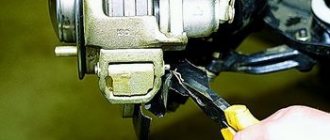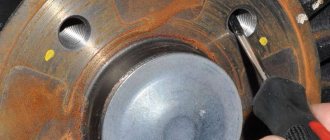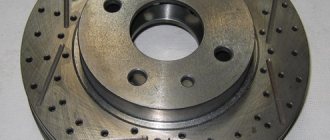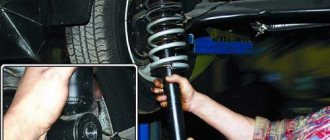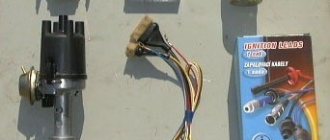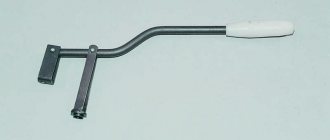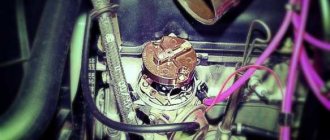The braking system ensures the safety of the car. One of the main components of this system is the brake pads. The braking efficiency depends on their reliability and quality. The pads have a certain service life, so it is necessary to periodically check and replace them.
What are they used for?
When you press the brake pedal, the pressure in the hydraulic system increases and the pads are pressed against the surface of the brake disc or drum. Structurally, a brake pad is a plate on which a lining made of a special material is attached. It contains various components: special rubbers and resins, ceramics, synthetic fibers. The composition may vary depending on the manufacturer. The main requirements that the lining must meet are high wear resistance and the ability to withstand high temperatures, resistance to destruction, but at the same time the material must cause minimal wear of the brake disc.
What are there
The VAZ 2106, like other “classics”, has disc brakes at the front and drum brakes at the rear.
Front brakes
The front end braking system is designed as follows:
- The brake disc is attached to the hub.
- The caliper is fixed to the steering knuckle of the suspension and holds two working cylinders.
- The brake pads are located between the disc and the cylinders.
When you press the brake pedal, the pistons move out of the cylinders, press on the pads and clamp the brake disc together. As a result, the car gradually slows down. The more force is applied to the brake pedal, the harder the pads clamp the disc.
The front brake pads are flat and smaller in size compared to the rear ones.
Rear brakes
Drum brakes on the VAZ 2106 consist of a drum itself, two shoes, a hydraulic cylinder and springs located under the drum. The pad linings are fixed using rivets or adhesive. The lower part of the pads rests against the supports, and the upper part rests against the cylinder pistons. Inside the drum they are tightened by a spring. To allow the wheel to rotate freely when stopping the car is not required, there is a gap between the pads and the drum.
When the driver presses the brake pedal, fluid is pumped into the slave cylinder, causing the pads to spread apart. They rest against the drum, thereby causing the rotation of the wheel to slow down.
Which ones are better
Owners of Zhiguli cars are often faced with the issue of choosing brake pads. The modern auto parts market offers products from different manufacturers. The parts differ in both quality and cost. The following brands of brake pads can be installed on VAZ cars:
- Ferodo (UK). The best products for brake systems that can be found on the automotive aftermarket today. The products are of high quality because they are made from reliable materials.
Prices for brake pads for VAZ 2106 start at 350 rubles. (AvtoVAZ) and reach 1,700 rubles. (ATE).
Adjusting the brakes
To correctly perform operations on adjusting the rear wheel brakes and handbrake , you can use the following recommendations:
- prepare the necessary tools for this case: a 13 mm open-end wrench, pliers, a combination wrench for fastening wheels, a 17 mm socket wrench. and probe 0.1-0.15 mm.
- place the car on an overpass or inspection ditch
- remove the rear wheel caps and loosen the wheel bolts
- raise the rear of the car and install stands
- Unscrew the wheel mounting bolts and remove the wheels.
It should be recalled that performing the described operation is quite inconvenient, since an assistant is required, who must be in the car while checking the brakes and carry out your simple commands.
If such an assistant is found, he, at your command, must press the brake pedal, and at this time, by rotating the drum, you determine whether the pads are in contact with the drum mirror.
If adjustment is required:
- keeping the pads pressed, turn the nut of the adjusting eccentrics 1 and 2 until they come into contact with the pads
- After releasing the brake pedal, turn the nuts in the opposite direction by about 10° so that the gap between the pads and the drum mirror is 0.10 - 0.15 mm.
- use a feeler gauge to check the set gap
- To be more sure, press the brake pedal sharply 3 - 4 times and check the gap again. If necessary, the adjustment should be repeated
- install the wheels, tighten their mounting bolts and check for ease of rotation. The wheels should rotate completely freely.
Scheme for adjusting the gap between the brake pads and the brake drum
There are times when the required gap between the pads and the drum cannot be established. This is a symptom of excessive wear on the brake pads and should be replaced with new ones.
The linings are replaced, naturally, with the drums removed. Removing a brake drum, even in a service station, is a rather labor-intensive operation.
The fact is that during operation, as a result of electrochemical corrosion, a drum cast from an aluminum alloy is, as it were, “welded” to the flange flange of an axle shaft made of steel. There are numerous recommendations and tips on how to quickly remove the drum.
It should be recalled that the use of various types of pullers does not give the desired result; moreover, the puller most often breaks the drum collar.
The easiest way to remove the drum is to use two mounting bolts 1, which are screwed into the technological holes 2 until the drum separates. However, as practice has shown, this method is effective when the car is “young”, i.e. its mileage is 3-5 thousand km.
If you cannot remove the drum using this method, you can do the following as a last resort:
- unscrew the guide pins from the drum
- lubricate the drum seat on the axle shaft with engine oil, start the engine and press the brake pedal
- engage first gear.
With the help of the described manipulations, it is almost always possible to free the drum, since it is held in place by the blocks, and the axle shaft rotates.
While rotating, the axle shaft makes a very unpleasant squeaking sound, but after 10 - 15 seconds, you can turn off the engine, release the brake pedal and remove the drum.
Replacing front pads
The need to replace brake pads on a VAZ 2106 arises when they are worn out or damaged due to the use of low-quality parts. If you don’t drive the car, you can drive about 50 thousand km on high-quality pads. However, there are situations when a part must be replaced after 5 thousand km. To replace the front pads on the “six” you need to prepare the following list of tools:
- "balloon" key;
- mounting blade;
- calipers;
- beard;
- pliers;
- new pads;
- hammer;
- file.
For repairs, the front wheels of the car are hung on a lift or raised with a jack.
Removal
The procedure for removing old pads is as follows:
- Unscrew the bolts and remove the wheel.
Installation
The assembly procedure consists of the following steps:
- We wipe the cylinders with a rag where they contact the pads.
- We inspect the anthers for rupture. If there is damage, replace the protective element.
Video: replacing front brake pads on a “classic”
Replacing rear brake pads on VAZ 2101-2107 cars
Reasons why you should start replacing the rear brake pads on VAZ-2101, VAZ-2104, VAZ-2105, VAZ-2106, VAZ-2107, Classic cars:
- The thickness of the rear brake pads is less than 2mm
- The lining of one of the pads has come off the metal surface (brake pads are always replaced as a set).
- oil or brake fluid getting on the linings.
List of tools and choice of work location for replacing rear brake pads on VAZ-2101-2107, Classic cars. Everything is simple here. It is better to carry out the work on a viewing hole or a lift, for two reasons - convenient access to the parking brake adjustment mechanism and the ability to quickly remove a stuck rear brake drum. An arsenal of necessary tools: a hammer, pliers, socket wrenches for 12, 13 and 7. Also, a special hook for removing and installing the tension springs of the rear brake pads will be useful. You can make such a device yourself or buy its analogue at the car market. Yes, you can do without it, using a screwdriver or pliers, but it will waste much more nerves.
Purpose and types of brake pads
Friction is used to stop a car. In the case of the VAZ 2107, this is the friction force of the pads on the brake disc (or on the brake drum, if the pads are rear). In general, the block is a steel plate with mounting holes, to which an overlay is attached using rivets. This is a rectangular plate made of a special material with a very high coefficient of friction. If the friction coefficient of the lining decreases for some reason, braking becomes less effective. And this immediately affects the quality and safety of driving.
Front pads
To brake the front wheels, flat, rectangular paired pads are used. The front wheels of the “seven” are equipped with massive steel discs that rotate synchronously with the wheels. When braking, rectangular pads compress the rotating disc on both sides. After this, the friction force provided by the linings comes into play, and the discs and wheels stop.
The front pads of the “seven” are ordinary rectangular plates with overlays
The pad plates are installed in a special device called a caliper. This is a massive steel housing with several holes, which houses the above brake disc with a pair of pads. The movement of the pads is ensured by special pistons in the braking cylinders. Liquid is supplied to the cylinders under high pressure and the pistons extend from them. The rod of each piston is attached to the pad, so that the pads also move and compress the brake disc, stopping it along with the wheel.
Rear pads
The rear pads on the “seven” have a fundamentally different design. If the front pads press on the disc from the outside, then the rear pads press from the inside, and not on the disc, but on the massive brake drum. For this reason, the rear pads are not flat, but C-shaped.
The rear brake pads of the “seven” are much longer than the front ones and have a C-shape
Each pad also has its own rectangular pad made of a special material, but the rear pads are much narrower and longer. These pads are also driven by cylinders, but they are double-sided cylinders, that is, the rods from such a cylinder can extend from both sides, so that it can move two brake pads at the same time. The pads are returned to their original position not by the rods (because they are not attached to the rods of the double-sided cylinder), but by a powerful return spring stretched between the pads. Here we should also mention the inner surface of the brake drums. Very serious requirements are placed on the quality of this surface. It's simple: the pads can be the best, but if the inner surface of the drum is worn out, if it is covered with cracks, scratches and chips, then braking will be far from ideal.
Replacing the rear brake pads of a VAZ 2107
Removal
This can be done both in the pit and on a lift. The main thing is to gain access to the torso of the handbrake. We put the “shoes” under the front wheels and get started.
Important! To change the rear pads, you need to remove the drum, and to do this, you cannot put the car on the handbrake or raise the handbrake lever to the top position. In this case, they will spread out in different directions, press against the walls of the drum and it will not be possible to remove it.
If you change pads, no matter the front or rear brakes, always change them in pairs - on two wheels of the same axle. Thus, there will be uniform wear and the wheels will brake with equal efficiency. Otherwise, you may spin out during emergency braking.
- Release the cable for adjusting the handbrake tension.
This is necessary so that the pads are not separated. Even a slight dilution can make it difficult to remove the brake drum. Let us remind you that the cable adjusting nuts are located under the car, in the center under the bottom. They are easy to find, one cable runs from the front of the car, and through these nuts it splits into two rear wheels.
- We hang the wheel, put stops under the front wheels, remove the wheel
- We clean the contact area between the drum and the axle shaft from dirt and rust.
You can use a metal brush or knife. We fill this place with WD-40; if it is not there, we make a WD-40 with our own hands and wait.
- We unscrew the guide pins and try to remove the drum from the axle shaft.
Often a bummer awaits us at this stage. He may get stuck well and won’t want to take off. In severe cases, he does not even move, there is no backlash. What to do in this case?
There is a folk method. In order to move the drum at least a little and rip it off the axle shaft, you need to start the car and accelerate the car into second gear as hard as possible and sharply press the brake. In most cases, the drum will fall off the axle shaft, sometimes it will fly out in the direction the wheels are moving.
Let's move on to the second stage of removal. The drum has some play, wobbles, spins around its axis, but does not want to come off the brake mechanism. In this case, you can use an impact tool - a hammer or use bolts as pullers.
The first option is more rigid, there is a chance of damaging the drum or splitting it into pieces. We climb into the hole, take a wooden block, place it against the edges of the drum and tap it with a hammer. Make a couple of blows on one side, turn the drum, make a few precise blows on the other side. Thus, it will gradually come off the brake pads. The main thing is that he doesn’t go skewed and catch the wedge.
The second option is bolts, like pullers. When unscrewing the guide pins, pay attention to the technological holes in the drum. They, unlike the holes for the pins, are threaded. We select bolts of the required diameter, usually “13”, and screw them in. We begin to tighten them evenly. They rest against the axle shaft, we twist them further. They pull the drum from the brake mechanism along the thread.
Important! The second option can be used if there is play in the drum and it rotates freely around the axle axis. Otherwise, you can “turn” the head of the bolts without achieving results.
Video on how to remove a brake drum, method 1 - severe case:
Video on how to remove a “stuck” drum using bolts as pullers (Method 2):
- Remove the washers of the support cups.
For ease of dismantling, it is recommended to start with a pad without a handbrake lever. Scroll the top washer until the pin matches the slot in it.
When should you change rear pads?
As mentioned above, if you hear a squeaking sound from the rear of the car when braking, then it’s time to check the rear brakes. This is the first sign that the pads need to be replaced. In addition, their resource does not exceed 40-50 thousand km, knowing the quality of spare parts, it is even less.
After opening the drum and visual inspection, if the thickness of the friction lining is less than 2-1.5 mm, we change the pads . It may be that the thickness is still sufficient, but chips are found on the working surface or the material has delaminated. There were times when it simply fell into the drum and there was nothing to slow it down. At the same time, a strong metallic grinding sound was transmitted into the cabin when the brake was pressed.
An indirect sign of the need for replacement can be a non-working “hand” brake. The handbrake tension adjustment cable is tightened, you are standing on a slope, lifting the parking brake handle, and the car is rolling - it’s time to change it. This method is not 100% correct, because there may be other factors that affect the serviceability of the handbrake.
We remove the old ones
We jack up the rear wheel of the VAZ 2107 and remove it. You must first take the necessary safety measures: install shoes under the wheels, place a safety stand under the body. This task is usually not difficult. Next it will be a little more difficult. It happens that the brake drum gets stuck to the axle shaft, and it is impossible to remove it using standard means.
In this case, the drum is “torn off” - the guides are unscrewed, the car is started, the gear is engaged and the speed is increased, and then the brake is sharply pressed.
Be very careful when performing this operation - ensure that the VAZ 2107 is securely secured so that it does not fall off the jack.
- We remove the brake drum and check the condition of the brake pad linings. In addition to wear, there may be a partial breakage of the linings, since, unlike the front ones, the rear ones are not solid. We determine whether one or both pads need to be replaced.
- Using a flat-head screwdriver, remove the lower tension spring;
- Using pliers, remove the spring clamps from the guides, turning them until the slots match;
- Using a screwdriver, press on one end of the upper spring and remove it.
This is the last action, after which nothing holds the pads anymore, and they fall.
Bleeding the brake system of VAZ 2106
Bleeding the brakes is done to remove air trapped in the brake system. It is easy to determine the presence of air: the brake pedal is initially pressed too softly, and after several presses it suddenly acquires an unusual “hardness”. These are signs of an air lock.
Sequencing
First of all, it should be said that it is best to bleed the brakes with an assistant. But with some skill, this can be done alone.
- First, check the brake fluid level. The tank must be filled to the upper marks.
- The fitting on the rear brake drum is unscrewed, a rubber hose is inserted in its place, and the other end of the hose is lowered into a plastic bottle.
- After this, the assistant sitting in the cab should press the brakes two or three times and then hold the pedal down for one minute.
- At this moment, the fitting is unscrewed so that brake fluid flows out of it through the hose. Air bubbles will be visible in it.
- After some time, the brake pedal will finally fall to the floor, which will be reported by the assistant. As soon as this happens, tighten the fitting and repeat all the above steps. This must be done until liquid with bubbles stops flowing from the hose.
- When the leaking brake fluid becomes normal, the bleeding procedure should be done with other wheels.
Video: bleeding the brakes alone
So, the brake system is the most important part of the car. And you should treat this part very responsibly. Fortunately, the brakes on the VAZ 2106 have never been particularly difficult. The main thing that a novice car enthusiast should do is to inspect and check them more often. And at the slightest suspicion of a malfunction, repair it immediately.
Sequence of actions when replacing rear pads
Preparatory stage: a set of automotive tools, rags, liquid for removing deposits, a new parking brake cable, graphite-based lubricant.
- We install the car on the inspection hole, fix the front wheels with wheel chocks, remove the rear wheel;
- Underneath the bottom, we unscrew (loosen) the handbrake cable for the convenience of carrying out maintenance work;
- Gently tap the drum guide bolts with a hammer. During operation and installation/disassembly, the bolts stick and are difficult to unscrew. If tapping does not help, spray with liquid to remove deposits, wait 10 minutes, then start unscrewing;
- After removing the drum cover, pay attention to the position of the parking brake lever. If it is not located near the lever, it means it is jammed and must be replaced. If you ignore this signal, it will be problematic to install the drum in its normal position;
- Remove the upper pressure spring, press the strut support, and turn it until it completely coincides with the slot. Remove the two cups and the spring from the stand;
- Disconnect the cable shank from the handbrake lever. We clean the disc from dirt, deposits, and rust;
- We carry out troubleshooting of the brake cylinder and seals. If there are signs of wear, leakage, or deformation, replace it with a new repair kit;
- We remove the parking brake lever from the old pads, take out the cotter pin and washer;
- Please note that the left and right levers are different and not interchangeable. Next, you need to install a spacer bar and move the pads apart. When installed correctly, the lugs are vertical;
- We start a new cable, fix it in the eye;
- We install new pads and assemble the structure in reverse order. If you have any difficulties with installation, it is better to watch the video presented in this manual.
The final stage: adjusting and tensioning the handbrake lever. In accordance with the requirements of the instruction manual, the handbrake should clamp the pads already at 5–6 clicks. Exceeding the norm indicates weakening, and decreasing indicates excessive tension.
Order of Operations
Work can be carried out without an inspection pit or overpass. The machine is placed on a flat surface and raised with a jack. Next, the following operations are performed:
- The car is set to speed, stops are installed under the front chassis, the rear wheels are “hung out” and removed.
Behind the wheel there is a drum that needs to be removed. If the knot has not been removed for a long time, it is most likely “stuck.” You can use WD tools for removal.
- After removing the drum, the brake pads are accessible. They can be inspected and cleaned of dirt. If the friction layer has reached a minimum, you should continue repairing the rear brake pads of the VAZ 2107.
- Then the connecting springs are dismantled: first the upper one, then the lower one. The operation is performed with a screwdriver; if necessary, you can use pliers.
- Now you can remove the clamps. They consist of a rod, a spring and a washer. The last elements need to be rotated 90 degrees and removed through the slots. The same procedure is performed on the other block.
- After this operation, the pads are easily removed.
- Now the cotter pin securing the handbrake is removed, then the parking brake. Next, the lever is removed; first you need to remove the washer.
The procedure for replacing brake pads can be seen in this video:
Brake pads LADA (VAZ 2103,2106)
The main division is based on brands and production materials. The list of the best manufacturers includes:. These companies have held leading positions in the list of the most popular brands for several years in a row and guarantee high quality products. Also, some motorists prefer original spare parts.
AvtoVAZ brake pads differ from analogues in their moderate cost and optimal efficiency. At the same time, the manufacturer does not recommend the use of serial versions for aggressive use for other purposes.
The front pads of the VAZ 2106 action can overheat the linings, which will cause the brake fluid to boil and the module to fail.
The material of the brake pads also differs.
Front disc brake pads for Lada 2106
A large selection of organic, ceramic and semi-metallic mixtures often confuses the motorist, which provokes him to make the wrong choice. The modification is the oldest variety. The first pads were made from organic material. The modification is designed to work under moderate loads. Typically, this variety is used on production vehicles for daily use in urban environments.
The advantages are moderate cost and sufficient prevalence. Buyers attribute rapid wear and low efficiency at high loads to the front pads of the VAZ 2106. The next subtype is used primarily on modified cars and is intended for more aggressive use under increased loads or high speeds.
Among the advantages of this subtype are stability of operation during overheating and during prolonged braking at high speed. The disadvantages include low prevalence in certain regions and high price. Front brake pad, SCT kit. Block in front of WEEN kit Block in front of Saturn kit. Front brake pads front VAZ 2106,,AT set. Front block, front blocks, VAZ 2106, LSA set.
Front brake pad, Phoenix set. Front brake pad, BEST set. Front brake pad, Dafmi Intelli kit.
Front brake pad , , , , , , ZARZ kit Online store.
Front brake pad, Hola BD kit. Front brake pad, FriCo kit.
How to independently replace the front and rear pads on a VAZ 2106
Preparatory stage: a set of automotive tools, rags, new pads, liquid to remove layers of rust and corrosion.
- Place the machine on a level platform. The option with an inspection hole or road overpass is excluded due to inefficiency;
- We jack up the front wheel with a hydraulic jack, remove it, having previously installed the wheel chocks;
- Use pliers to remove the guide pins. Please pay attention to the pressure springs; they may fly out during the work;
- Using a flat-tip screwdriver, press the slave cylinder into its original position. We widen the gaps to remove the brake pads;
- We remove worn pads, carry out preventive maintenance on the brake caliper, and clean it from rust and deposits. If necessary, use a liquid like WD-40;
- Replace with new pads, assemble the structure in reverse order.
Subject to the above recommendations and the purchase of original spare parts, the service life of the brake system elements is 20 - 25 thousand km. mileage A moderate driving style and average ambient temperatures will increase the service life by 5 - 7 thousand km.


